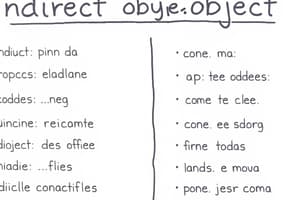Podcast
Questions and Answers
What is a direct object pronoun?
What is a direct object pronoun?
A direct object pronoun answers the question WHO or WHAT receives the action of the verb.
In the example 'Miguel bought a gift at Target', what was bought?
In the example 'Miguel bought a gift at Target', what was bought?
The gift.
Match the following direct object pronouns with their meanings:
Match the following direct object pronouns with their meanings:
Me = Me Te = You Lo = Him/It La = Her/It Nos = Us Los = Them Las = Them
When should you use direct object pronouns?
When should you use direct object pronouns?
What is an indirect object pronoun?
What is an indirect object pronoun?
Match the following indirect object pronouns with their meanings:
Match the following indirect object pronouns with their meanings:
When should you use indirect object pronouns?
When should you use indirect object pronouns?
Where do DOPs and IOPs always go?
Where do DOPs and IOPs always go?
When can pronouns be attached to the end of a verb?
When can pronouns be attached to the end of a verb?
What should you do when 'le/les' and 'lo/los' are used in the same sentence?
What should you do when 'le/les' and 'lo/los' are used in the same sentence?
When using DOP and IOP in the same sentence, which goes first?
When using DOP and IOP in the same sentence, which goes first?
Flashcards are hidden until you start studying
Study Notes
Direct Object Pronouns (DOP)
- Direct object pronoun identifies WHO or WHAT receives the action of a verb.
- Example: In "Miguel bought a gift at Target," the direct object is "the gift," answering the question, "What was bought?"
Direct Object Pronouns List
- Me = me
- Te = you
- Lo = him/it
- La = her/it
- Nos = us
- Los = them (masculine)
- Las = them (feminine)
DOP Usage
- Direct object pronouns must be placed right before the verb in a sentence.
- Example: "Lo tengo" (I have it).
Indirect Object Pronouns (IOP)
- Indirect object pronouns always refer to a person; they indicate to whom the action of the verb is directed.
- Answers the question "To whom?".
Indirect Object Pronouns List
- Me = to me, for me
- Te = to you, for you
- Le = to you (formal), for you
- Nos = to us, for us
- Les = to you all, to them, for them
- Note: Use "a ella, a Maria, a los chicos" for clarification when using "le" or "les."
IOP Usage
- Indirect object pronouns are also placed right before the verb in a sentence.
Placement of DOPs and IOPs
- Both direct and indirect object pronouns precede the conjugated verb.
- They may be attached to the end of an infinitive verb or used in commands.
- Example: "Dime la verdad" (Tell me the truth).
Special Cases in Sentences
- When both "le" or "les" and "lo" or "los" are present in the same sentence, change "le" or "les" to "se."
Order of Pronouns
- When using both DOPs and IOPs in a sentence, the indirect object pronoun (IOP) always comes before the direct object pronoun (DOP).
Studying That Suits You
Use AI to generate personalized quizzes and flashcards to suit your learning preferences.




